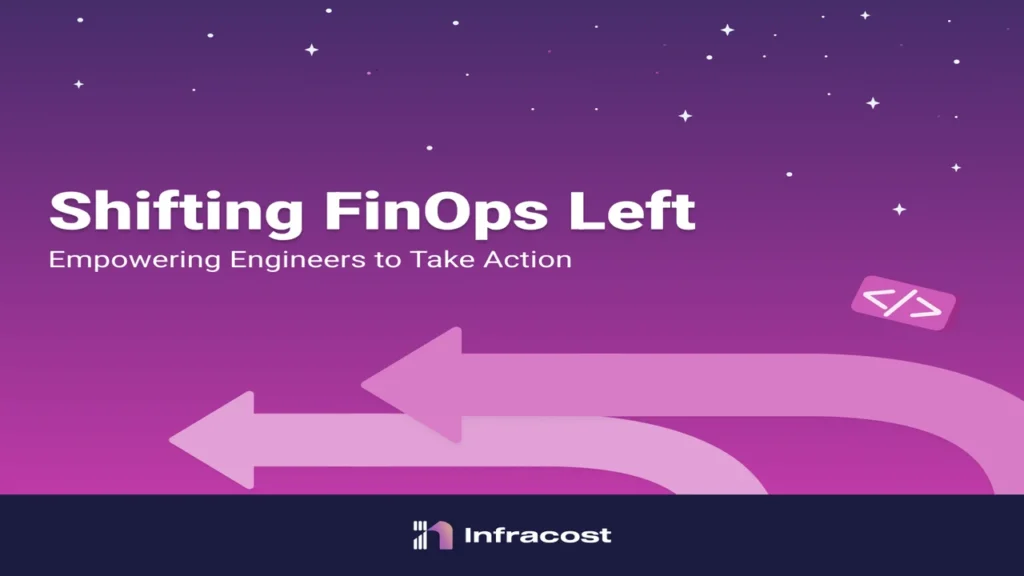The importance of taking a proactive stance in financial management is growing as more and more organizations depend on cloud-native development. Integrating financial factors into the initial phases of the development lifecycle, or “shifting left” in FinOps, is more than a strategy; it’s a game-changer for driving innovation and efficiency. In this follow-up, Accelerate Innovation by Shifting Left FinOps, Part 2, we take a closer look at how companies can use early financial integration to transform their operations and establish a cost-conscious culture without sacrificing speed or creativity.
Who Benefits from Shifting Left FinOps?

Moving to the left DevOps teams, CFOs, cloud architects, and company executives are just a few of the many groups that stand to benefit greatly from FinOps. As a result, DevOps teams are able to make better decisions that take both performance and costs into account. Better forecasting and budget alignment are made possible when financial planners gain early visibility into project expenditures. By optimizing resource usage from the start, cloud architects can prevent costly redesigns in the future. Key drivers in a competitive marketplace include improved profitability, faster delivery timelines, and more cost-efficient projects.
Understanding the Foundations of Shifting Left in FinOps

Proactive Cost Management in FinOps
Typically, financial operations (FinOps) respond after the fact, fixing budget problems that arise after the fact. By incorporating cost management strategies at an early stage of the development lifecycle, this model is transformed when one shifts to the left.
Reasons to Start Saving Money Right Away
To avoid being caught unawares by budget constraints later on, development teams should engage in proactive financial planning. They can then align their technical and financial goals with well-informed decisions.
Integrating FinOps in Agile Development
Iterative progress and rapid pivots are the lifeblood of agile development. To improve flexibility without going over budget, incorporate FinOps into agile methodologies. This will make sure that financial considerations are a part of every sprint.
Real-Time Financial Insights for Teams
As projects progress, teams can monitor spending compared to their budgets with the help of real-time cost visibility tools and practices. This helps to reduce waste and inefficiencies.
Collaboration Between Financial and Technical Teams
Financial analysts and developers can work together more effectively in a left-shifting environment. All project stakeholders will be aware of the financial ramifications at every turn thanks to this coordination.
Creating a Robust FinOps Cost Model
Key Components of a FinOps Cost Model
The first step in moving to the left in FinOps is creating a detailed cost model. To get the whole financial picture, the model has to account for all the different types of costs.
Infrastructure Costs and Their Role
The three main components of any cloud application are compute, storage, and network resources. To avoid unforeseen expenses when scaling, it is important to accurately predict these costs.
Balancing Application and Licensing Costs
It is important to thoroughly assess application-related costs, including runtime environments and third-party licensing fees. Legal compliance and effective cost management are achieved through proper licensing planning.
Incorporating Data and Support Costs
It is critical for businesses to comprehend and anticipate the costs of data acquisition, storage, and processing as they move towards being data-driven. Financial forecasts are further refined by including support services costs.
Understanding Unit Economics in FinOps
Unit economics evaluates the cost and revenue per unit of a product or service. Companies may improve their pricing tactics and operational expenditures by examining profitability in great detail.
Implementing Shifting Left FinOps Strategies
Establishing Clear Financial Policies
Financial policies should be defined early on so that teams have a plan to follow. Budget caps, approval procedures, and accountability measures are all part of these policies, which are meant to keep departments on the same page.
Investing in Team Training and Awareness
With the correct FinOps training, teams can find ways to save money and adjust their processes to meet their financial objectives. Responsibility for cost management is fostered through training.
Automation makes cost tracking and reporting easier when used for financial operations. Teams can stay on budget and concentrate on development with the help of real-time insights provided by tools like AWS Cost Explorer or Google Cloud’s Cost Management.
Iterative Review and Refinement Processes
Making the switch to FinOps’s left side is an ongoing process. To keep up with changing project requirements and company objectives, it’s a good idea to review cost models and strategies on a regular basis.
Measuring Success in Shifting Left FinOps
To gauge the efficacy of FinOps strategies, key performance indicators (KPIs) like ROI on cloud resources, cost per deployment, and team compliance with financial policies can be defined.
Benefits of Early Financial Integration in Development
Enhanced Cost Visibility for Stakeholders
Moving to the left Stakeholders can make data-driven decisions that align with strategic objectives with FinOps’s transparent cost view of the project from the start.
Improved Operational Efficiency
Reducing delays and bottlenecks brought on by unanticipated financial constraints, early cost management streamlines workflows.
Faster Time to Market for Products
Products can be brought to market faster and take advantage of opportunities when teams tackle cost considerations early on, preventing rework and delays.
Increased Financial Accountability in Teams
Each team member knows their part to play in efficient cost management when FinOps practices are embedded.
Long-Term Progress in Sustainability By Using a Balanced Cost-Performance Model
The long-term viability of innovation depends on striking a balance between performance and cost efficiency, which can be achieved by shifting to the left.
Embedding FinOps in Complex Development Lifecycles
Defining Financial Accountability in Development
Managing budget concerns after they emerge is a common practice in traditional software development, where financial oversight tends to be reactive. By incorporating FinOps into intricate development lifecycles, responsibility is shifted to the forefront, guaranteeing that financial consequences are taken into account in addition to technical decisions.
Role of Financial Stakeholders in Agile Frameworks
Agile development frameworks that include financial stakeholders encourage ongoing teamwork. As a result, there is less chance of going over budget and more likelihood that sprint goals will be in line with technical outcomes.
Integrating FinOps with CI/CD Pipelines
Development becomes much easier with CI/CD pipelines, which stand for Continuous Integration and Continuous Deployment. Teams can make adjustments to their strategies during development instead of after deployment thanks to real-time cost metrics tracked by FinOps embedded into CI/CD.
Leveraging Data Analytics for Financial Insights
Predictive insights into trends in resource consumption and costs can be provided by advanced analytics platforms. Companies can use these tools to predict how their investments will pan out before making any major decisions about development or operations.
Ensuring Scalability in Cost Models
A scalable cost model is essential for ever-increasing development lifecycle complexity. Achieving financial sustainability in the long run requires the development of dynamic models that can adapt to changing workloads and infrastructure requirements.
Comparing Traditional and Shifting Left Financial Approaches
Key Differences in Financial Oversight
Moving to the left places an emphasis on proactive, ongoing cost management, in contrast to the conventional wisdom that financial oversight is best practiced through analysis of past performance. Reducing inefficiencies and improving resource allocation hinges on this difference.
Impact on Resource Utilization
Due to delayed cost analysis, resources may be over-allocated under traditional methods. By keeping an eye on the development’s financial impact, shifting to the left guarantees efficient use of resources.
Improved Teamwork and Collaboration Across Departments
Misalignment between financial and technical teams is a result of traditional methods that separate them. By breaking down these barriers, shifting to the left forms cross-functional teams that share responsibility for financial results.
Speed and Agility in Decision-Making
Making decisions faster by incorporating real-time financial insights is possible by shifting to the left. This is in contrast to more conventional approaches, which put off making necessary adjustments until the end of the reporting cycle for financial statements.
Long-Term Strategic Benefits
In contrast to the often-seen short-term benefits of conventional methods, organizations that embrace a shifting left approach experience long-term financial health and innovation.
Case Studies: Success Stories in Shifting Left FinOps
Case Study 1: A SaaS Company’s Journey to FinOps Excellence
Cloud computing’s ever-increasing price tag was a growth inhibitor for a prominent SaaS provider. The business added cost visibility to its CI/CD pipeline by embracing a FinOps strategy that shifted to the left. The result was a 35% decrease in cloud waste, which they were able to put back into product development.
Case Study 2: FinOps Transformation in an E-Commerce Giant
Cost overruns plagued an e-commerce behemoth with extensive cloud operations. Financial decision-making was made easier with the help of automated cost tracking tools and financial analysts who were embedded within DevOps teams, which improved operational efficiency by 20%.
Case Study 3: A Startup’s Agile FinOps Adoption
A tech startup was able to better coordinate their development efforts with their limited budget by utilizing shifting left FinOps. They were able to reduce wasteful spending while scaling and achieve faster time-to-market by integrating financial metrics into their agile workflows.
Key Takeaways from Real-World Examples
The case studies presented here demonstrate how shifting left in FinOps can be applied anywhere. Early integration of financial practices yields measurable benefits, including cost reductions, faster delivery, and enhanced collaboration, in both startups and established enterprises.
Strategic Implementation of Shifting Left FinOps
Building a Culture of Financial Awareness
For the shift to go well, it’s important to foster an environment where everyone knows and appreciates their role in the team’s financial responsibility. Meeting regularly for training or attending workshops and maintaining open lines of communication can help accomplish this.
Choosing the Right Tools for Implementation
You can’t put a price on quality. An organization’s size and complexity should be considered when selecting a robust FinOps platform. Quick action is possible with the help of platforms that provide budget forecasting, automated alerts, and real-time dashboards.
Setting Measurable Goals and KPIs
It is critical to measure the success of FinOps initiatives. We can gain actionable insights into performance through key performance indicators (KPIs) like cost per deployment, resource utilization efficiency, and time-to-market improvements.
Encouraging Collaboration Across Departments
Successful FinOps adoption is characterized by cross-departmental collaboration. Financial experts can be a valuable asset to DevOps teams, helping organizations make well-rounded decisions that take technical and financial outcomes into account.
Iterative Refinement for Long-Term Success
The FinOps process is iterative. The approach stays in sync with the changing demands of the business and the market when cost models, strategies, and key performance indicators are reviewed on a regular basis.
The Road Ahead: Future of Shifting Left FinOps
Emerging Trends in FinOps Practices
Adaptations to FinOps practices will be ongoing as technology progresses. Predictive analytics, real-time collaboration tools, and AI-driven cost management are some of the trends that will influence the future of shifting left.
The Role of AI and Automation in FinOps
By automating mundane operations, providing better insights into cost patterns, and paving the way for predictive financial planning, artificial intelligence and machine learning are on the verge of transforming financial operations.
Strengthening Sustainability Through FinOps
Organizations can align their FinOps strategies with sustainability goals by optimizing resource use and minimizing waste, contributing to environmental and financial benefits.
Expanding FinOps Beyond Development
Although FinOps was originally developed for software development, its principles can be used to drive innovation and cost efficiency in other areas of a company’s operations, including marketing.
Achieving Competitive Advantage with Shifting Left
Businesses can stand out in crowded marketplaces, provide customers with superior goods, and keep their finances in check by embracing an integrated and proactive cost management strategy.
FAQs
What is the primary goal of shifting left FinOps?
The primary goal is to integrate financial considerations early in the software development lifecycle, ensuring cost efficiency and alignment with business objectives from the start.
How does shifting left improve collaboration?
Shifting left fosters collaboration between financial and technical teams, aligning their efforts and creating a shared understanding of cost implications at every stage.
What challenges do organizations face when shifting left?
Challenges include resistance to change, lack of awareness, and inadequate tools or training. Addressing these through proper planning and investment can smooth the transition.
What tools are essential for automating FinOps processes?
Popular tools include AWS Cost Explorer, Google Cloud’s Billing, and Kubernetes’ cost management integrations. These provide actionable insights into cost data in real time.
How does shifting left impact time to market?
By proactively addressing cost-related bottlenecks early, shifting left reduces delays, enabling faster product delivery and improved market responsiveness.
Also Read: TuGuiaUSA: Trabajos en Estados Unidos
Conclusion
ncreasing the rate of innovation by moving to the left FinOps is a paradigm shift that enables organizations to balance cost efficiency with performance; it’s more than just a strategy. Quicker delivery, better collaboration, and long-term growth can be achieved when teams incorporate financial considerations early on in the development lifecycle. Accelerate Innovation by Shifting Left FinOps, Part 2 explores cutting-edge FinOps tools and technologies, examining their use in hybrid cloud environments and offering practical advice for developing your own FinOps plan. Adopting shifting left FinOps practices is crucial for staying ahead in an increasingly competitive world as the digital landscape evolves.

